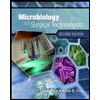
Concept explainers
The genetic material (RNA or DNA) of an organism or cell is defined as the materials present in the mitochondria, nucleus, and cytoplasm. The genetic material plays an essential role in defining the nature and structure of the cell substances.
Explanation of Solution
An organism is any individual entity that embodies the properties of life. Organisms are classified by taxonomy into groups such as multicellular animals, plants, and
Deoxyribonucleic acid (DNA) is a molecule composed of two polynucleotide chains. It coils around each other to form a double helix carrying genetic instructions for functioning, development, growth, and reproduction of all known organisms.
The difference between basic genetic structures of DNA between organisms are as follows:
| DNA in eukaryotes | DNA in prokaryotes |
|
Eukaryotes such as plants and animals have chromosomes that contain linear and large molecules of DNA. |
Prokaryotes such as Escherichia coli consists of a single circular molecule of DNA. |
| The DNA in eukaryotes is found inside the nucleus. | The DNA in prokaryotes is found in a coiled loop floating in the cytoplasm. |
| The size of DNA in eukaryotes is high, generally more than 1pg. | The size of DNA in prokaryotes is less than 0.1 pg. |
| More than one copy of the genome is present in the DNA of eukaryotes. | In prokaryotes, the DNA contains one copy of the genome. |
Ribonucleic acid (RNA) is a
The difference between basic genetic structures of RNA between organisms are as follows:
| RNA in eukaryotes | RNA in prokaryotes |
| The messenger RNA of the eukaryote is monocistronic. | The messenger RNA of a prokaryote is polycistronic. |
| The eukaryotic mRNA consists of a single gene transcribed into molecules of mRNA. | In prokaryotic mRNA, several structural genes of an operon are transcribed into a single mRNA. |
| Eukaryotic mRNA consists of both 5' cap and 3' tail. | Prokaryotic mRNA does not consist of a 5' cap and 3' tail. |
| The size of ribosomal RNA present in eukaryotic cells is the 80S. | The size of ribosomal RNA present in the prokaryotic cells is the 70S. |
Want to see more full solutions like this?
Chapter 7 Solutions
Microbiology for Surgical Technologists
- Amino Acid Coclow TABle 3' Gly Phe Leu (G) (F) (L) 3- Val (V) Arg (R) Ser (S) Ala (A) Lys (K) CAG G Glu Asp (E) (D) Ser (S) CCCAGUCAGUCAGUCAG 0204 C U A G C Asn (N) G 4 A AGU C GU (5) AC C UGA A G5 C CUGACUGACUGACUGAC Thr (T) Met (M) lle £€ (1) U 4 G Tyr Σε (Y) U Cys (C) C A G Trp (W) 3' U C A Leu בוט His Pro (P) ££ (H) Gin (Q) Arg 흐름 (R) (L) Start Stop 8. Transcription and Translation Practice: (Video 10-1 and 10-2) A. Below is the sense strand of a DNA gene. Using the sense strand, create the antisense DNA strand and label the 5' and 3' ends. B. Use the antisense strand that you create in part A as a template to create the mRNA transcript of the gene and label the 5' and 3' ends. C. Translate the mRNA you produced in part B into the polypeptide sequence making sure to follow all the rules of translation. 5'-AGCATGACTAATAGTTGTTGAGCTGTC-3' (sense strand) 4arrow_forwardWhat is the structure and function of Eukaryotic cells, including their organelles? How are Eukaryotic cells different than Prokaryotic cells, in terms of evolution which form of the cell might have came first? How do Eukaryotic cells become malignant (cancerous)?arrow_forwardWhat are the roles of DNA and proteins inside of the cell? What are the building blocks or molecular components of the DNA and proteins? How are proteins produced within the cell? What connection is there between DNA, proteins, and the cell cycle? What is the relationship between DNA, proteins, and Cancer?arrow_forward
- please fill in the empty sports, thank you!arrow_forwardIn one paragraph show how atoms and they're structure are related to the structure of dna and proteins. Talk about what atoms are. what they're made of, why chemical bonding is important to DNA?arrow_forwardWhat are the structure and properties of atoms and chemical bonds (especially how they relate to DNA and proteins).arrow_forward
- The Sentinel Cell: Nature’s Answer to Cancer?arrow_forwardMolecular Biology Question You are working to characterize a novel protein in mice. Analysis shows that high levels of the primary transcript that codes for this protein are found in tissue from the brain, muscle, liver, and pancreas. However, an antibody that recognizes the C-terminal portion of the protein indicates that the protein is present in brain, muscle, and liver, but not in the pancreas. What is the most likely explanation for this result?arrow_forwardMolecular Biology Explain/discuss how “slow stop” and “quick/fast stop” mutants wereused to identify different protein involved in DNA replication in E. coli.arrow_forward
 Microbiology for Surgical Technologists (MindTap ...BiologyISBN:9781111306663Author:Margaret Rodriguez, Paul PricePublisher:Cengage Learning
Microbiology for Surgical Technologists (MindTap ...BiologyISBN:9781111306663Author:Margaret Rodriguez, Paul PricePublisher:Cengage Learning Human Heredity: Principles and Issues (MindTap Co...BiologyISBN:9781305251052Author:Michael CummingsPublisher:Cengage Learning
Human Heredity: Principles and Issues (MindTap Co...BiologyISBN:9781305251052Author:Michael CummingsPublisher:Cengage Learning Biology (MindTap Course List)BiologyISBN:9781337392938Author:Eldra Solomon, Charles Martin, Diana W. Martin, Linda R. BergPublisher:Cengage Learning
Biology (MindTap Course List)BiologyISBN:9781337392938Author:Eldra Solomon, Charles Martin, Diana W. Martin, Linda R. BergPublisher:Cengage Learning Comprehensive Medical Assisting: Administrative a...NursingISBN:9781305964792Author:Wilburta Q. Lindh, Carol D. Tamparo, Barbara M. Dahl, Julie Morris, Cindy CorreaPublisher:Cengage Learning
Comprehensive Medical Assisting: Administrative a...NursingISBN:9781305964792Author:Wilburta Q. Lindh, Carol D. Tamparo, Barbara M. Dahl, Julie Morris, Cindy CorreaPublisher:Cengage Learning





